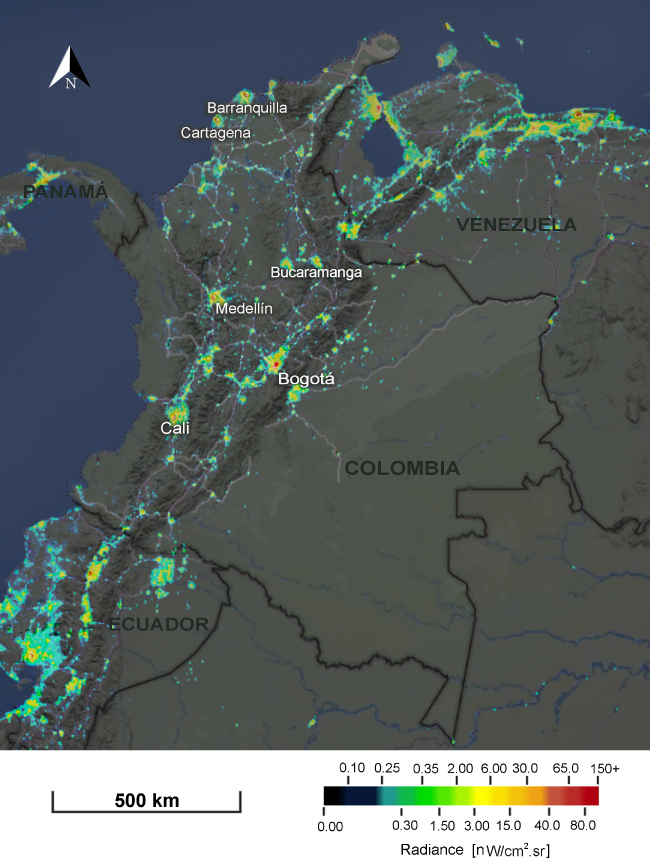Resumen
La contaminación lumínica es una forma de degradación ambiental que aumenta cada vez más en todo el mundo y afecta el entorno natural, la flora, la fauna y varios aspectos de la vida humana. A pesar de la creciente preocupación por esta problemática, en Colombia su estudio es aún muy limitado. Aquí analizamos de forma exhaustiva la expansión de la luz nocturna artificial en las principales ciudades de Colombia entre el 2012 y el 2022. Se evidenció así un aumento en los niveles de contaminación lumínica en las áreas urbanas de Bogotá, Barranquilla y Cartagena, en tanto que en las de Medellín, Cali y Bucaramanga disminuyó la radiancia promedio. Sin embargo, en todas las ciudades consideradas en el estudio la cobertura de áreas iluminadas aumentó, con un evidente incremento espacial del fenómeno. En el caso de Bogotá, se analizó detalladamente el fenómeno a nivel de localidades y, a partir de datos externos, se verificaron, además, las relaciones del aumento de la contaminación lumínica con la instalación de nuevas luminarias, el cambio a tecnología
LED, y el crecimiento de la densidad poblacional y el producto interno bruto de la ciudad. Nuestros resultados brindan información valiosa sobre la creciente amenaza de la contaminación lumínica en Colombia y respaldan la necesidad de tomar medidas que ayuden a controlar la degradación ambiental asociada.
Referencias
Altamar-Consuegra, A. del S., Meneses-Velosa, S. L., Arias, C., Vallejo-Moreno, G., Herrera-Ladino, D.A., Herrera- Ladino, I.A., Mercado-Suárez, Á.L., Medina-Vargas, M.R., Giraldo-Arcila, S.V., Góez- Therán, C., Vargas-Domínguez, S., Echeverri-Gutiérrez, P.A., Valencia-Salazar, J.D., Aristizábal-Torres, D., Gutiérrez, A.S., Barrera-Rodríguez, A.M., Ramírez-Castañeda, L.N., Obregón-Neira, N., González-Angarita, G.P., …,Giraldo-Castro, N. (2020). Desarrollo sostenible: casos y aplicaciones en el contexto colombiano. http://hdl.handle.net/10882/12237
Bará, S., Bao-Varela, C., Falchi, F. (2022). Light pollution and the concentration of anthropogenic photons in the terrestrial atmosphere. arXiv e-prints, arXiv:2210.14131.
Basu, C., Meinhardt-Wollweber, M., Roth, B. (2013). Lighting with laser diodes. Advanced Optical Technologies, 2(4), 313-321. https://doi.org/10.1515/aot-2013-0031
Bortle, J. E. (2001). Introducing the Bortle Dark-Sky Scale. Sky and Telescope, 101(2), 126. Brieva, E. (1985, March). Search for a Site for an Astrophysical Station in Colombia - Preliminary Results. Revista Mexicana de Astronomía y Astrofísica, 10(1), 397.
Cinzano, P., Falchi, F., Elvidge, C. D. (2001). The first World Atlas of the artificial night sky brightness. Monthly Notices of the Royal Astronomical Society, 328(3), 689-707.
De Servicios Públicos, U. A. E. (2022). Alumbrado público, Bogotá D.C. Retrieved from https://datosabiertos.bogota.gov.co/dataset/
Falchi, F., Cinzano, P., Duriscoe, D., Kyba, C.C.M., Elvidge, C.D., Baugh, K., Portnov, B.A., Rybnikova, N.A., Furgoni, R. (2016). The new world atlas of artificial night sky brightness. Science Advances, 2(6), e1600377-e1600377
Falchi, F., Ramos, F., Bará, S., Sanhueza, P., Jaque Arancibia, M., Damke, G., Cinzano, P. (2022). Light pollution indicators for all the major astronomical observatories. Monthly Notices of the Royal Astronomical Society, 519(1), 26-33. Gallaway, T., Olsen, R. N., Mitchell, D. M. (2010). The economics of global light pollution. Ecological economics, 69(3), 658-665.
Góez-Therán, C., Vargas-Domínguez, S. (2021). Comparative Analysis of Sky Quality and Meteorological Variables During the Total Lunar Eclipse on 14-15 April 2014 and their Effect on Qualitative Measurements of the Bortle Scale. Revista Mexicana de Astronomía y Astrofísica, 57(1), 57-66.
Han, G., Zhou, T., Sun, Y., Zhu, S. (2022). The relationship between night-time light and socioeconomic factors in China and India. PLOS ONE, 17(1), 1-22.
Herrera, O.J.M. (2015). El proceso de urbanización en los municipios de la sabana de Bogotá. Ánfora: Revista Científica de la Universidad Autónoma de Manizales, 22(38), 85-111.
Hölker, F., Moss, T., Griefahn, B., Kloas, W., Voigt, C.C., Henckel, D., Hänel, A., Kappeler, P.M., Völker, S., Schwope,A., Franke, S., Uhrlandt, D., Fischer, J., Klenke, R., Wolter, C., Tockner. K. (2010). The dark side of light: a transdisciplinary research agenda for light pollution policy. Ecology and Society, 15(4), 13. URL: http://www.ecologyandsociety.org/vol15/iss4/art13/
Kyba, C.C.M., Hölker, F. (2013). Do artificially illuminated skies affect biodiversity in nocturnal landscapes? Landscape Ecology, 28(1), 1637-1640.
Kyba, C.C.M., Garz, S., Kuechly, H., De Miguel, A. S., Zamorano, J., Fischer, J., Hölker, F. (2015). High-resolution imagery of earth at night: New sources, opportunities and challenges. Remote Sensing, 7(1), 1-23.
Kyba, C. C. M., Ö ner Altıntas¸, Y., Walker, C. E., Newhouse, M. (2023). Citizen scientists report global rapid reductions in the visibility of stars from 2011 to 2022. Science, 379(6629), 265-268.
Pinzón, G., González, D., Ramírez, A. (2016). Análisis comparativo de seis lugares de interés para la ubicación de instrumentación astronómica en Colombia. Revista de la Academia Colombiana de Ciencias Exactas, Físicas y Naturales, 40(154), 53-68.
Stone, T. (2017). Light pollution: A case study in framing an environmental problem. Ethics, Policy & Environment, 20(3), 279-293.
Sánchez-de Miguel, A., Bennie, J., Rosenfeld, E., Dzurjak, S., Gaston, K. J. (2021). First estimation of global trends in nocturnal power emissions reveals acceleration of light pollution. Remote Sensing, 13(16), 1-12.
Secretaría Distrital de Planeación, Subsecretaría de Información y Estudios Estratégicos, Dirección de Estudios Macro. (2005). Dinámica de los movimientos migratorios entre Bogotá y su área metropolitana, y sus implicaciones en el mercado de vivienda en la región, 2005-2050. Secretaría Distrital de Planeación.
Tamir, R., Lerner, A., Haspel, C., Dubinsky, Z., Iluz, D. (2017). The spectral and spatial distribution of light pollution in the waters of the northern Gulf of Aqaba (Eilat). Scientific Reports, 7, 42329, 1-10.
Unidad Administrativa Especial de Servicios Públicos, UAESP. (2022). Alumbrado público, Bogotá, D.C. https://datosabiertos.bogota.gov.co/dataset/70e93f88
Wang, Z., Shrestha, R. M., Román, M. O., Kalb, V. L. (2022). Nasa’s black marble multiangle nighttime lights temporal composites. IEEE Geoscience and Remote Sensing Letters, 19(1), 1-5.

Esta obra está bajo una licencia internacional Creative Commons Atribución-NoComercial-SinDerivadas 4.0.
Derechos de autor 2023 Revista de la Academia Colombiana de Ciencias Exactas, Físicas y Naturales

